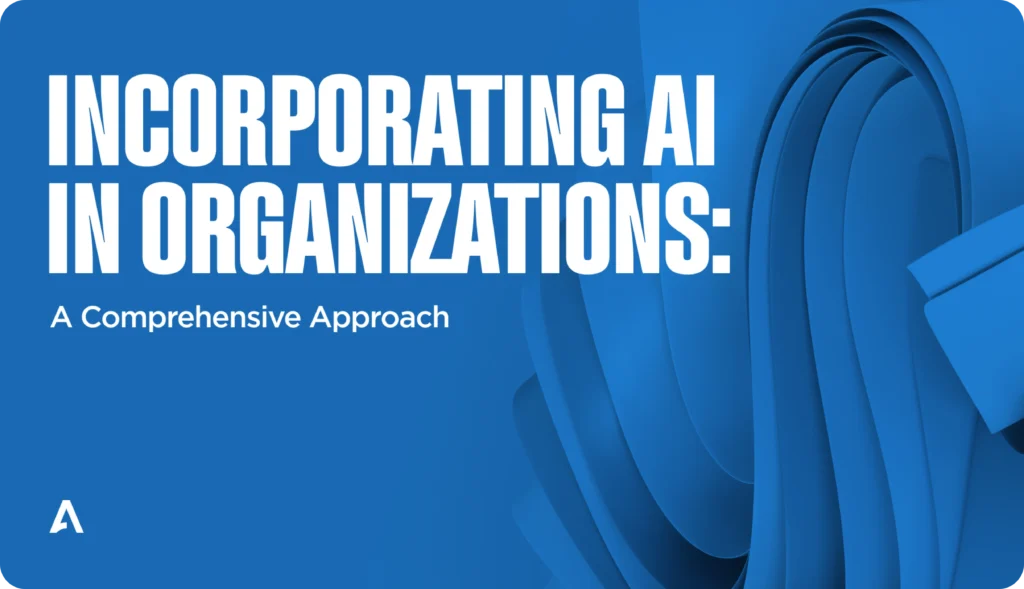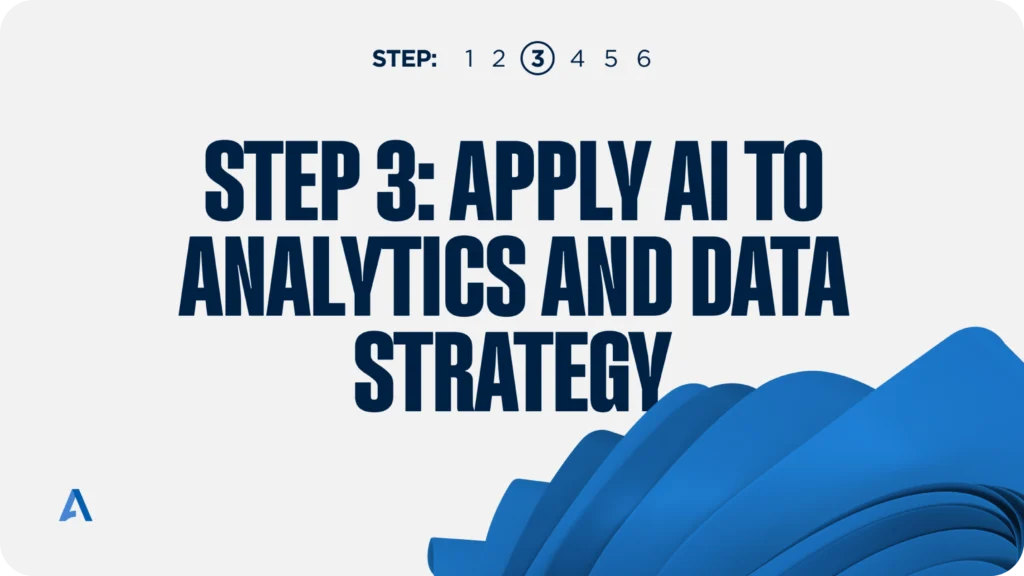
As organisations stride into the era of AI, we must recognize that adopting AI goes beyond technological upgrades. Instead, it’s a transformative journey that demands strategic navigation.
The comprehensive 6-step approach we use at Alba explores both the technical aspects of AI integration and the role of change management. Intertwining these practices completes 2 missions:
- Smoothens the integration of AI technologies
- Ensures that the organization evolves harmoniously as it embraces AI-driven transformations.
- Let’s dive in and break down our 6 steps of AI incorporation, including their purposes, implementation, and integration with change management.
Step 1: Develop a Clear Vision for AI within the Organization
If you fail to plan, then you are planning to fail. This is why before starting the implementation of AI systems, it’s crucial to map out every step you’ll be taking.
- Purpose
Establishing a coherent vision for AI is pivotal for its successful integration. This vision becomes the guiding principle for any future AI endeavors, ensuring that you stay aligned with your organization’s broader goals.
- Implementation
Planning involves the engagement of key stakeholders to understand the current landscape of the industry and foresee how AI can shape the future.
From town hall meetings and workshops to brainstorming sessions, creating this shared vision can be achieved in endless ways.
- Change Management Integration
Key stakeholders must be engaged not only in the creation of the AI vision but also in shaping the narrative of how AI will positively impact their roles and the organization as a whole. In other words, understand not only the plan but also the ultimate purpose of AI integration.
The vision of change should be simple, clear, and well-communicated to all stakeholders.
Step 2: Identify the Value of Use Cases
Not every task needs AI. In other words, don’t implement AI just for the sake of implementing it.
- Purpose
Identifying the right use cases means targeting areas where AI can have the most meaningful impact.
- Implementation
Carry out feasibility studies and cost-benefit analyses. Prioritize use cases that align with the organization’s objectives and offer a high return on investment. Be transparent and measure ROI for every case.
- Change Management Integration
Take the identification of AI use cases as an opportunity to redefine how work is done, rather than just implementing a new technology. Don’t be scared to recreate workflows and eliminate bottlenecks from their roots.
For success, collaborate with the teams that will be affected by AI. Ask them to identify pain points and areas where AI could bring valuable changes to their tasks. In this case, they know best what is working and what isn’t.
Step 3: Apply AI to Analytics and Data Strategy

The main superpower of AI is its data analytics speed, accuracy, and pattern recognition. If you’re going to be implementing AI anywhere, it should be here.
- Purpose
AI can provide deeper insights, predict trends, and uncover hidden patterns in huge datasets. At the end of the day, your computing power goes up and up.
- Implementation
Start by integrating AI tools into existing analytics platforms. Ensure that the data infrastructure is robust, and data quality is maintained. As powerful as AI is, it is still fueled by data, and if the data is biased, so will the results.
Lastly, encourage a culture of data-driven decision-making, augmented by AI-powered insights.
- Change Management Integration
To promote a culture that embraces data-driven decision-making and AI-powered insights, you must demonstrate how these changes align with the organization’s values and how they will enhance job roles.
Tangible actions you can take here include offering training on AI tools and analytics platforms to boost confidence and competence among employees.
You can also hold workshops with Leadership members to challenge limiting beliefs/blockers to culture change.
Last but not least, reward small and consistent behavioural efforts within the team.
Step 4: Organization Planning with New AI Roles in Mind
With the introduction of AI, roles are bound to change and evolve. Be ready to face this challenge with open arms.
- Purpose
As AI becomes integral, new roles like AI specialists, data scientists, and AI ethicists may become essential. Nobody said that AI doesn’t require maintenance.
- Implementation
Assess current personnel to identify potential upskilling opportunities. For entirely new roles, consider hiring subject matter experts or collaborating with specialized firms to tackle this issue.
One thing is for sure, you must continue to offer training opportunities to keep the team updated with the latest in AI.
- Change Management Integration
Empower employees by providing them with accessible opportunities for upskilling and growth. The fear of being replaced by AI must be eliminated because AI is here to support, not replace.
By providing transparent communication about how AI-related roles will be integrated, and offering pathways for existing employees to transition into these roles, you can effectively support your employees through their learning curve.
Step 5: Purpose-Built AI Models
Making sure every aspect of your new AI models is put to good use is crucial. Customizing to your organization’s needs is part 2.
- Purpose
Generic AI models might not cater to specific organizational needs you may have. On the other side, tailored models can address unique challenges and goals.
- Implementation
Collaborate with AI experts to design custom models. Use proprietary data to train these models, ensuring they are attuned to your organization’s specific nuances. Put strategic purpose in each and every model to see the highest possible result metrics.
- Change Management Integration
Involve end-users and teams who will be using the AI models in the design process to create a sense of ownership and enthusiasm for the new solutions.
For the best possible outcomes, you should foster an environment where feedback is valued and team contribution is visibly incorporated.
Step 6: Evaluate the Impact of AI on Key Performance Indicators (KPIs)
Incorporating AI in your day-to-day operations is useless if you’re not tracking your results. Being dynamic in your use of AI is the key to success.
- Purpose
It’s vital to measure AI’s contribution to ensure it’s driving the intended value. Tracking your results will empower you to make necessary adjustments whenever they arise.
- Implementation
Develop a set of KPIs linked to AI initiatives. Monitor these regularly an d adjust your strategies based on performance. Iterate on a continuous basis to stay dynamic and change before you need to.
This iterative process ensures that AI efforts remain aligned with organizational goals and continue to deliver value.
- Change Management Integration
For successful implementation, your communications plan must regularly update teams on the current impact, progress within KPIs, successes, and potential areas for improvement.
To ensure buy-in throughout your organization’s AI journey, use accessible language for all of your stakeholders and employees.
Bonus step: Customized Hardware for AI Applications

As AI models and applications grow more and more complex, the demand for computational power also rises. Off-the-shelf hardware components may not always meet the specific needs of advanced AI tasks, leading to inefficiencies. But there is always a solution.
Investing in customized hardware will optimize your performance, energy efficiency, and bring faster processing for AI operations.
Implementation
- Assessment of Needs: Preparing for implementation should always be step 1 of any endeavour. Begin by analyzing the specific computational demands of your AI applications. Different tasks like neural network training, real-time processing, or vast data analytics may have varying requirements. Track these needs to be able to address them better.
- Field-Programmable Gate Arrays (FPGAs) and Application-Specific Integrated Circuits (ASICs): ASICs are customizable hardware components tailored for specific tasks. For example, Google’s Tensor Processing Units (TPUs) are ASICs designed specifically for neural network machine learning. By using such tailored hardware, organizations can achieve faster computation speeds and energy efficiency.
- Hardware-Software Co-optimization: Ensure that the AI software and custom hardware are optimized to work in tandem. This harmonization can lead to improved performance, reduced latency, and better resource allocation.
- Scalability and Flexibility: When designing custom hardware tailored to your organization’s needs, consider future scalability and the possibility of incorporating newer algorithms or techniques in the short and long term. The hardware should be flexible enough to accommodate growth and changes in the AI models that you forecast.
- Collaboration with Experts: Partner with hardware design firms or hire in-house teams to develop and iterate on the custom hardware designs. Given the rapid evolution of AI, regular hardware updates and iterations will be necessary. Be proactive rather than reactive.
- Cost-Benefit Analysis: Custom hardware may involve significant investments. Carry out a thorough cost-benefit analysis to ensure that the performance gains and efficiencies derived from the customized hardware justify their costs. At the end of the day, it’s all about your bottom line.
- Change Management Integration: Where possible, involve technical teams in the hardware selection process and provide training to ensure that they are comfortable working with new hardware solutions. If the hardware will impact a wider group of stakeholders, minimize the complexity and detail of communication to enhance positive buy-in and receptiveness of new ways of working. Temporary losses in productivity are to be expected, so make sure you can deal with them when they arise.
Conclusion
In summary, embracing AI in organizations requires a holistic approach, converging both technical advancements and change management strategies.
The comprehensive strategy we’ve presented should be used to empower organizations to excel in the transformative AI era, emphasizing the integration of technology and change management for success. For more information or guidance, reach out to our experts at Alba Partners.

Name Surname
Lorem ipsum dolor sit amet, consectetur adipiscing elit. Phasellus at ante luctus, tempus diam congue, tristique sapien. Praesent blandit
Popular Blogs
A Comprehensive Approach
